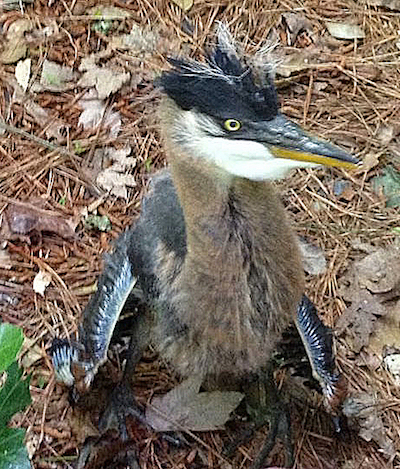Great Blue Heron
DONATE
We hope you enjoy watching this webcam. If you would like to help us preserve their habitat, please donate.
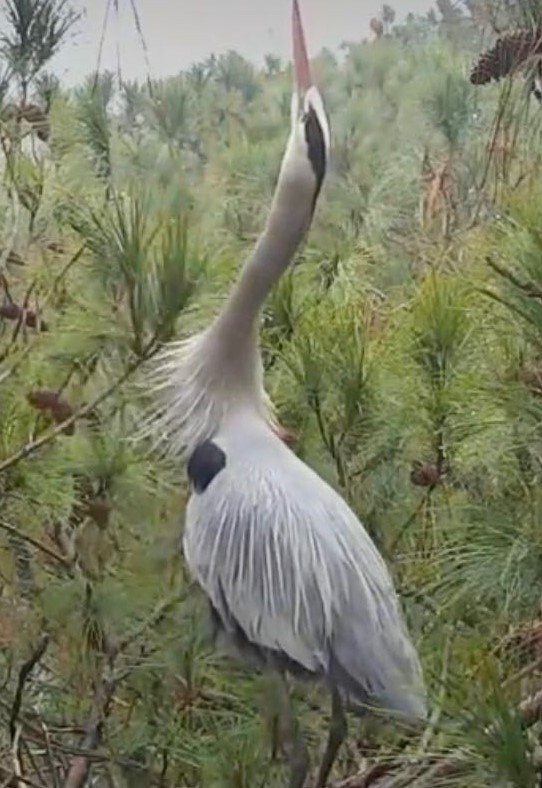
About This Great Blue Heron Cam
Our great blue heron cam on Maryland’s Eastern Shore was launched in 2016 with funds generated through a crowdfunding campaign and additional help from Waterfowl Chesapeake. Explore.org joined the partnership in 2017 and installed a new sophisticated camera in 2018. The homeowner chose to name the main couple featured in the cam, “Rell & Eddie” after the surfers Rell Sunn and Eddie Aikau.
There are 10-12 nests in this rookery on Maryland’s Eastern Shore and up to 50 heron. The cam features 3 nests prominently. Others can be seen in the distance. Viewers will be amazed at how crowded these nests get with two adults and up to 3-4 chicks!
They are 100 feet up in loblolly pine trees.
Viewers will see these beautiful birds mate, incubate and care for their young.
Great blue herons select new mates every year, laying 2-7 eggs. These eggs are then incubated approximately 28 days until hatching. The young are then fed for around 60 days in the nest by both parents.
2024:
The camera went live in mid-February following the return of several Great Blue Herons to the colony. The property owner discovered scat on the property and heard squawking from the rookery residents. The herons began to rebuild and update their nests for the next season. Throughout this cam history, the herons tend to lay eggs in mid-to-late March so hopefully we’ll see some egg evidence soon!
2023 Recap
The camera went live in early-February following the return of several Great Blue Herons to the colony. This season features an upgraded camera which allows a better look into a nest. In previous years, the herons of the colony laid their eggs in late-March and early-April. On April 9, the property owner discovered an eggshell on the ground. Here’s hoping we see and hear some heron chicks soon!
The night of Monday, May 22, we received a report from the property owner & neighbor that the heron nest was attacked by a great horned owl. Unfortunately, one of the heron chicks fell out of the nest and the other chick passed following the attack. The fallen chick was rescued by Tri-State Bird Rescue, but sadly passed due to its injuries, bringing the season to an untimely close.
2022 Recap
The heron cam went live in early-March after the herons’ return was confirmed by the property owner. It’s believed the herons laid their eggs in late-March, with an incubation period of of 26 – 30 days, as eggshells were discovered on the property in late-April.
Though it was a spotty season since the herons were elusive, the property owner informed us that the herons started to fledge from rookery in early-June.
2021 Recap
The Great Blue Herons returned in late-February and early-March and began to rebuild their nests. After high winds knocked the camera out of commission, the camera was restored in late-March. In late-April, the property owner found several eggshells under the trees of the rookery. This means that there are chicks up there in the tree, we can’t wait to see them soon!
The property owner and several eagle-eyed viewers were able to discern four chicks in the featured nest. Following a contest, the four heron chicks were named Charlize Heron, Cobalt, Lapis, and Blue.
2020 Recap
The Herons returned on February 25 and started work on their nests, with the landowner confirming their arrival. After reconstructing their nests, the various Great Blue Heron nests began to lay and incubate their eggs.
Nest 1: The Great Blue Herons of Nest 1 laid their 1st egg at 1:31 am of March 18. Their 2nd egg was laid at 11:55pm of March 19. The 3rd egg was laid on March 21 at 10:08pm. Lastly, the 4th egg was laid on Mar 24 at 1:01am. Thank you to CamOp Pan for these specific times and dates! Two eggs hatched in the afternoon of April 15. The final two eggs hatched April 18 and April 19. Unfortunately, two of the older chicks attacked and killed the two younger chicks over the weekend of May 2. While sad, this is not unusual behavior and may have occurred due to food competition.
2019 Recap
The herons returned to the rookery in early March and began reconstruction of their nests. Following reconstruction, the various heron nests began to lay eggs and incubate.
Nest 1: Rell & Eddie laid 5 eggs on Mar 31, Apr 3, Apr 5, Apr 7, and Apr 9. Three of the five eggs became damaged in an unknown manner and were removed from the nest on April 10. The remaining two eggs hatched on April 29 and May 3. The chicks began to fledge in mid-to-late June as Great Blue Heron chicks fledge around 49 to 81 days after hatching. Following our annual, public bird-naming contest, the two chicks were named Lucy & Ricky on July 12.
Nest 2: Unfortunately, there were no chicks in this nest during the season.
Nest 3: While we do not have certain dates of when the eggs were laid, five chicks were observed in the nest as of May 22. One chick was lost after being found on the forest floor by the property owner. The chicks began to fledge around early to mid-June as the chicks hatched earlier compared to Nest 1.
2018 Recap
 Nest 1: Rell & Eddie had 4 eggs this season, starting on Mar 28, Mar 30, Apr 1 and Apr 3. The first two eggs hatched on Apr 26 at 12:41pm and 2:14pm, the third egg on Apr 27 at 7:47pm and the final egg sometime before 7:54am. Sadly, the two youngest chicks passed away late afternoon May 16 and the evening of May 17. Following a public vote, the remaining chicks were named Azure and Woodstock. Woodstock fledged June 30, and Azure fledged July 7.
Nest 1: Rell & Eddie had 4 eggs this season, starting on Mar 28, Mar 30, Apr 1 and Apr 3. The first two eggs hatched on Apr 26 at 12:41pm and 2:14pm, the third egg on Apr 27 at 7:47pm and the final egg sometime before 7:54am. Sadly, the two youngest chicks passed away late afternoon May 16 and the evening of May 17. Following a public vote, the remaining chicks were named Azure and Woodstock. Woodstock fledged June 30, and Azure fledged July 7.
2017 Recap
 Rell and Eddie had four chicks – one sadly did not make it. The nest grew to be quite crowded with 3 very large chicks and their parents.
Rell and Eddie had four chicks – one sadly did not make it. The nest grew to be quite crowded with 3 very large chicks and their parents.
2016 Recap
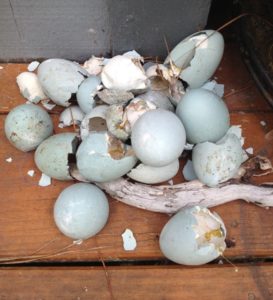 In February 2016, a private homeowner contacted the Chesapeake Conservancy expressing an interest in sharing the rookery located on their property with the world via a webcam. For the last ten years, the property has been home to between 10 and 12 nests, and as many as 50 herons, 100 feet off the ground in loblolly pine trees.
In February 2016, a private homeowner contacted the Chesapeake Conservancy expressing an interest in sharing the rookery located on their property with the world via a webcam. For the last ten years, the property has been home to between 10 and 12 nests, and as many as 50 herons, 100 feet off the ground in loblolly pine trees.
The Chesapeake Conservancy launched an online crowdfunding campaign to finance the new cam. Between crowdfunding and a generous sponsorship by Waterfowl Chesapeake, the Chesapeake Conservancy raised $10,000 and launched the new cam on April 4, 2016.
The Chesapeake Conservancy was thrilled with this chance to share these majestic birds with the public. We often see great blue heron soaring in the sky or hunting fish by the water’s edge, but rarely do we get to see them up close and at home in their rookery. We are also very grateful to the homeowner who is lucky enough to have this magnificent habitat in their backyard and is willing to share it with the world.
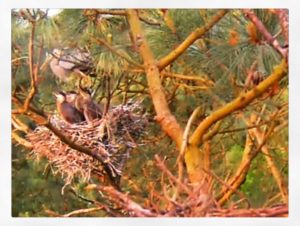 The homeowner chose to name the couple “Rell & Eddie” after the surfers Rell Sunn and Eddie Aikau. On April 23, 2016, their three eggs hatched. After a public vote, Rell and Eddie’s chicks were named Felix, Lafayette and Moe.
The homeowner chose to name the couple “Rell & Eddie” after the surfers Rell Sunn and Eddie Aikau. On April 23, 2016, their three eggs hatched. After a public vote, Rell and Eddie’s chicks were named Felix, Lafayette and Moe.
Great Blue Heron cam features a wider-angle view to capture activity from multiple nests, as well as infrared night vision to see in darkness. During the 2016 season, two nests could be seen on the camera. One was home to two herons who alternated incubation of their eggs.
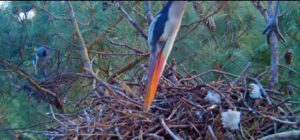 We’re very grateful to the more than 125 individuals who donated to the GoFundMe campaign, the more than 800 individuals who shared it and helped get the word out, and to Waterfowl Chesapeake for their very generous co-sponsorship. The cam is powered by Mediacom, who donated equipment and Internet services for the live-stream. Skyline Technology Solutions, Inc., based in Glen Burnie, MD, provided a discounted installation rate and equipment. Skyline also supports the Chesapeake Conservancy’s osprey and peregrine falcon cams. Axis Communications also provided discounted equipment. Generously, a tree company based in Rehoboth, DE, donated their services to mount the cam in the 100-foot-tall pine.https://chesapeakeconservancy.org/wp-content/uploads/2016/11/Great-Blue-Bandit-300×140.jpg
We’re very grateful to the more than 125 individuals who donated to the GoFundMe campaign, the more than 800 individuals who shared it and helped get the word out, and to Waterfowl Chesapeake for their very generous co-sponsorship. The cam is powered by Mediacom, who donated equipment and Internet services for the live-stream. Skyline Technology Solutions, Inc., based in Glen Burnie, MD, provided a discounted installation rate and equipment. Skyline also supports the Chesapeake Conservancy’s osprey and peregrine falcon cams. Axis Communications also provided discounted equipment. Generously, a tree company based in Rehoboth, DE, donated their services to mount the cam in the 100-foot-tall pine.https://chesapeakeconservancy.org/wp-content/uploads/2016/11/Great-Blue-Bandit-300×140.jpg
About Great Blue Herons
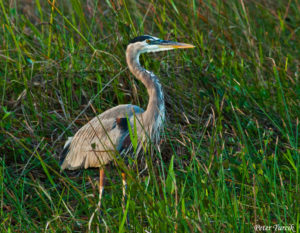
According to the Chesapeake Bay Program’s website, great blue herons live in colonies called rookeries. These tall, bluish-gray wading birds have long, pointed bills and graceful, S-shaped necks. They live year-round in marshes and wetlands throughout the Chesapeake Bay region and are also found on freshwater lakes, ponds and impoundments.
The great blue heron grows to 4 feet tall with a 6 to 7 foot wingspan. Despite its large size, its hollow bones allow it to weigh only 5 to 6 pounds. The great blue heron eats mostly fish, but will also feed on insects, amphibians, crustaceans and other small animals. It silently stalks its prey in shallow waters, and then plunges its bill into the water to capture it. It will spend about 90 percent of its waking hours hunting for food.
Learn more about the great blue heron with our frequently asked questions and fun facts. To learn more about the Bay’s other amazing creatures use our National Wildlife Refuge App, or visit one of our region’s many national and state parks and refuges to see them in the wild!
If you enjoy our Great Blue Heron Cam, please consider donating to the Chesapeake Conservancy to help us in our efforts to protect their Chesapeake habitat.

